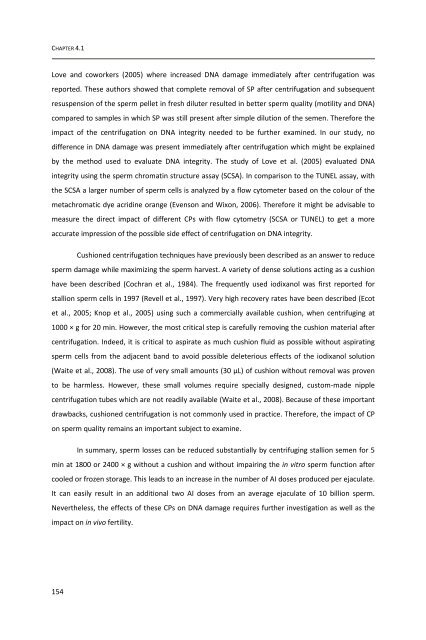view - Department of Reproduction, Obstetrics and Herd Health
view - Department of Reproduction, Obstetrics and Herd Health
view - Department of Reproduction, Obstetrics and Herd Health
You also want an ePaper? Increase the reach of your titles
YUMPU automatically turns print PDFs into web optimized ePapers that Google loves.
CHAPTER 4.1<br />
Love <strong>and</strong> coworkers (2005) where increased DNA damage immediately after centrifugation was<br />
reported. These authors showed that complete removal <strong>of</strong> SP after centrifugation <strong>and</strong> subsequent<br />
resuspension <strong>of</strong> the sperm pellet in fresh diluter resulted in better sperm quality (motility <strong>and</strong> DNA)<br />
compared to samples in which SP was still present after simple dilution <strong>of</strong> the semen. Therefore the<br />
impact <strong>of</strong> the centrifugation on DNA integrity needed to be further examined. In our study, no<br />
difference in DNA damage was present immediately after centrifugation which might be explained<br />
by the method used to evaluate DNA integrity. The study <strong>of</strong> Love et al. (2005) evaluated DNA<br />
integrity using the sperm chromatin structure assay (SCSA). In comparison to the TUNEL assay, with<br />
the SCSA a larger number <strong>of</strong> sperm cells is analyzed by a flow cytometer based on the colour <strong>of</strong> the<br />
metachromatic dye acridine orange (Evenson <strong>and</strong> Wixon, 2006). Therefore it might be advisable to<br />
measure the direct impact <strong>of</strong> different CPs with flow cytometry (SCSA or TUNEL) to get a more<br />
accurate impression <strong>of</strong> the possible side effect <strong>of</strong> centrifugation on DNA integrity.<br />
154<br />
Cushioned centrifugation techniques have previously been described as an answer to reduce<br />
sperm damage while maximizing the sperm harvest. A variety <strong>of</strong> dense solutions acting as a cushion<br />
have been described (Cochran et al., 1984). The frequently used iodixanol was first reported for<br />
stallion sperm cells in 1997 (Revell et al., 1997). Very high recovery rates have been described (Ecot<br />
et al., 2005; Knop et al., 2005) using such a commercially available cushion, when centrifuging at<br />
1000 × g for 20 min. However, the most critical step is carefully removing the cushion material after<br />
centrifugation. Indeed, it is critical to aspirate as much cushion fluid as possible without aspirating<br />
sperm cells from the adjacent b<strong>and</strong> to avoid possible deleterious effects <strong>of</strong> the iodixanol solution<br />
(Waite et al., 2008). The use <strong>of</strong> very small amounts (30 µL) <strong>of</strong> cushion without removal was proven<br />
to be harmless. However, these small volumes require specially designed, custom-made nipple<br />
centrifugation tubes which are not readily available (Waite et al., 2008). Because <strong>of</strong> these important<br />
drawbacks, cushioned centrifugation is not commonly used in practice. Therefore, the impact <strong>of</strong> CP<br />
on sperm quality remains an important subject to examine.<br />
In summary, sperm losses can be reduced substantially by centrifuging stallion semen for 5<br />
min at 1800 or 2400 × g without a cushion <strong>and</strong> without impairing the in vitro sperm function after<br />
cooled or frozen storage. This leads to an increase in the number <strong>of</strong> AI doses produced per ejaculate.<br />
It can easily result in an additional two AI doses from an average ejaculate <strong>of</strong> 10 billion sperm.<br />
Nevertheless, the effects <strong>of</strong> these CPs on DNA damage requires further investigation as well as the<br />
impact on in vivo fertility.









